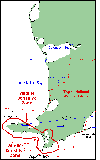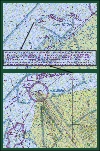Wildlife Flight Advisories - Alaska
Cape Lisburne NEW!, Cape Newenham, Cape Peirce, Cape Seniavin, Icy Cape NEW!, St. George Island & St. Paul Island
Posted Monday October 6, 2008
This page incorporates five pre-existing advisory areas currently listed in the Alaska Supplement and adds two new areas, (Cape Lisburne and Icy Cape).

View Image (PDF, 2.5 MB)

View Image (PDF, 81 KB)

View Image (PDF, 71 KB)
Preferred Arrival & Departure Routes into the Airports at St. George & St. Paul Islands
The National Marine Fisheries Service and the U.S. Fish and Wildlife Service requests pilots maintain a minimum altitude of 1,000 feet above ground level (AGL) within a 1 mile radius of any of the coastline of the Pribilof Islands (St. Paul, St. George, Sea Lion Rock, Walrus, and Otter Islands) from 14 May until 14 December. Flights less than 1,000 feet AGL and less than 1 mile seaward or � mile landward may harass marine mammals and seabirds. Harassment of wildlife may increase the incidence of bird strikes and violate the Marine Mammal Protection Act.
During approach and takeoff from St. George to the east a right bank turn is recommended between � and 1 mile from the end of the runway to heading 060� True or 240� True. During approach and takeoff from St. Paul follow aircraft advisory corridors to the north and south. Inter-island flights along heading 138� True or 318� True should avoid the aircraft advisory zones if less than 1,000 feet AGL and within 1 mile of any coastline except as recommended above.

View Image (PDF, 52 KB)
YOUR SUPPORT AND COOPERATION IS REQUESTED TO
MINIMIZE DISTURBANCE TO WALRUS RESTING
AT CAPE NEWHENHAM AND CAPE PEIRCE
THESE ARE IMPORTANT RESTING AREAS FOR PACIFIC WALRUS. Each summer, thousands of walrus migrate into Bristol Bay to feed on rich beds of clams and other marine organisms. Between feeding cycles, they come to shore to rest at isolated resting areas (haulouts) distributed around the shoreline in the Togiak National Wildlife Refuge.
WALRUS ARE SENSITIVE TO HUMAN DISTURBANCES.Although responses to human activities are variable, walrus will often flee haulouts in response to the sight, sound, or odor of humans or their machines. Trampling deaths associated with haulout disturbance is one of the largest known sources of natural mortality for walrus. Frequent or prolonged disturbances may even result in long term haulout abandonment.
DISTURBING WALRUS IS AGAINST THE LAW. Operating an aircraft or boat in a manner which results in disturbing, harassing, herding, hazing, or driving of walrus is prohibited under provisions of the Marine Mammals Protection Act and Federal Airborne Hunting Act.
YOU CAN HELP MINIMIZE DISTURBANCES TO WALRUS AT CAPE NEWENHAM AND CAPE PEIRCE. To ensure that walrus are not disturbed, please follow these guidelines between April 1st and October 31st when traveling near Cape Newenham and Cape Peirce:
- Fixed wing aircraft remain at altitudes greater thatn 2,000 feet above ground level (AGL) within 1/2 mile of Togiak National Wildlife Refuge boundary within one (1) nautical mile of the boundary. If cloud conditions necessitate flying lower than these recommended altitudes, please pass inland to avoid flushing walrus from the beach.
- Walrus are particularly sensitive to changes in engine noise and are more likely to stampede off beaches when planes turn or fly low overhead - please avoid circling or turning while in the area of the haulout.
- Aircraft visiting Togiak National Wildlife Refuge should land well away from the haulout and only taxi as close to the haulout as is necessary for landing and take off. Approaching the haulout by foot will greatly reduce the amount of disturbance to the animals resting at the haulout.
- Marine vessels are requested to remain at least 1/2 mile from shore when transiting past Cape Newenhame and Cape Peirce.
THANK YOU FOR YOUR HELP AND COOPERATION.
To report incidences of harassment contact:
- USFWS Law Enforcement Division: 1-800-858-7621
- United States Department of the Interior
Fish and Wildlife Service
Marine Mammals Management Field Office
1011 E. Tudor Road
Anchorage Alaska 99503-6199
Toll free: 1-800-362-5148; fax 786-3816

View Image (PDF, 59 KB)
YOUR SUPPORT AND COOPERATION IS REQUESTED TO
MINIMIZE DISTURBANCE TO WALRUS RESTING AT CAPE SENIAVIN
CAPE SENIAVIN IS AN IMPORTANT RESTING AREA FOR PACIFIC WALRUS. Each summer, thousands of walrus migrate into Bristol Bay to feed on rich beds of clams and other marine organisms. Between feeding cycles, they come to shore to rest at isolated resting areas (haulouts) distributed around the Bay. In recent years, the number of walrus using the haulout at Cape Seniavin on the Alaska Peninsula has increased substantially and this haulout has become one of the most important resting areas for walrus in Alaska.
WALRUS ARE SENSITIVE TO HUMAN DISTURBANCES.Although responses to human activities are variable, walrus will often flee haulouts in response to the sight, sound, or odor of humans or their machines. Trampling deaths associated with haulout disturbance is one of the largest known sources of natural mortality for walrus. Frequent or prolonged disturbances may even result in long term haulout abandonment.
DISTURBING WALRUS IS AGAINST THE LAW. Operating an aircraft or boat in a manner which results in disturbing, harassing, herding, hazing, or driving of walrus is prohibited under provisions of the Marine Mammals Protection Act and Federal Airborne Hunting Act.
YOU CAN HELP MINIMIZE DISTURBANCES TO WALRUS AT CAPE SENIAVIN. To ensure that walrus are not disturbed, please follow these guidelines between April 1st and October 31st when traveling near Cape Seniavin:
- Fixed wing aircraft remain at altitudes greater than 2,000 feet above ground level (AGL) within 1/2 mile of Cape Seniavin (56� 24' N, 160� 09' W). Helicopters remain at altitudes greater than 5,000 feet AGL within one (1) nautical mile of the Cape. If cloud conditions necessitate flying lower than these recommended altitudes, please pass inland to avoid flushing walrus from the beach.
- Walrus are particularly sensitive to changes in engine noise and are more likely to stampede off beaches when planes turn or fly low overhead - please avoid circling or turning while in the area of the haulout.
- Aircraft visiting Cape Seniavin should land well away from the haulout and only taxi as close to the haulout as is necessary for landing and take off. Approaching the haulout by foot will greatly reduce the amount of disturbance to the animals resting at the haulout.
- Marine vessels are requested to remain at least 1/2 mile from shore when transiting past the Cape.
THANK YOU FOR YOUR HELP AND COOPERATION.
To report incidences of harassment contact:
- USFWS Law Enforcement Division: 1-800-858-7621
- United States Department of the Interior
Fish and Wildlife Service
Marine Mammals Management Field Office
1011 E. Tudor Road
Anchorage Alaska 99503-6199
Toll free: 1-800-362-5148; fax 786-3816

View Image (PDF, 568 KB)
Please Review the Attached FWS Advisory for the Cape Lisburne, Icy Cape Areas
View FWS Document (PDF, 64 KB)
Questions?
Last updated: Friday, April 30, 2021
